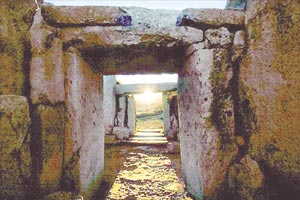To celebrate
the seasonal changes of the year, therefore, is all about
re-connecting. We become re-connected to nature, since celebrating
the seasons leads us to acknowledge the role that nature plays in our lives
despite all the cultural developments that have allowed us to change our
environment and surroundings for better and for worse. We become re-connected
to our selves and our lives, since in the cycles of nature we can see our
own psychological experiences being reflected. Finally we also become
reconnected to our spirituality, especially by drawing on the vast reservoir
of culutural imagery and mythological cycles that our ancestors have left
us as their legacy.
 Spring Equinox at Mnajdra, a 6000 year
old temple in Malta
Spring Equinox at Mnajdra, a 6000 year
old temple in Malta
which is aligned with the Equinoxes and the Solstices.
|